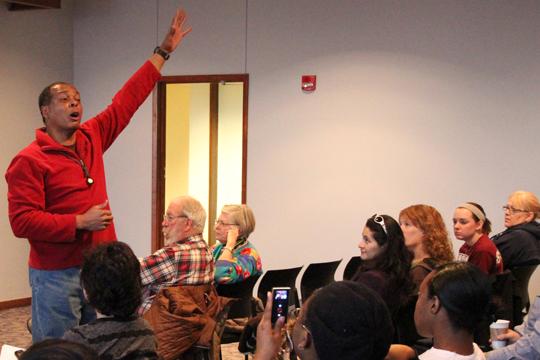VIDEO: Speaker shares stories of heroism in African-American history
February 21, 2012
Washburn students received a history lesson on the Kansas underground railroad from a guest spaker last Thursday.
Richard Pitts is the executive director of the Wonder Workshop in Manhattan and the author of the book “A Self-Guided Tour of the Underground Railroad in Kansas.”
On Feb. 16, Pitts gave an impassioned lecture on the Underground Railroad and Black History.
Pitts started off playing a drum before launching into his lecture. He said that “talking drums” were one of the things that were taken away from slaves when they arrived in the Americas “because it was a way for them to communicate over long distances.”
“[This was part of the history] which was very significant to me,”
said Pitts. “That’s why I picked up drums. I wanted to be like my ancestors.”
Pitts dramatically brought to life stories of unthinkable slave conditions with visual aids, including a whip. He gave vivid examples of the many and varied rebellions and wars throughout the years along the Underground Railroad. Asking questions to involve the audience, he related the fighting between the Jayhawkers of Kansas and the Bushwhackers of Missouri.
“People in Lawrence today probably don’t know about the history they walk by every day,” said Pitts.
There are still bullet holes and scars left on buildings from the raids and burnings of the town.
Topeka was the free state capitol in Kansas, while Lecompton was the pro-slavery capitol. The original building that housed the free state movement in Topeka from 1885-1869 is still standing on Topeka Boulevard, two blocks north of the capitol. It’s the one that now sports a large mural. Another historic building still standing is The Owens House in North Topeka, famous for its status as an Underground Railway station.
Pitts said that the Underground Railroad, as well as the Civil Rights Movement show “where different races of people worked together—of both genders. Those are the examples we want to hold up to kids. They struggled, but at the same time, they helped each other, and they made things happen.”
He believes people need to know that there are also many more powerful African and African-American leaders to learn about alongside Martin Luther King, adding, “Our kids need to know that there are so many examples of heroes and heroines from all walks of life working together, of different races.”
“What made these people, black, white and Native American” come together to do these extraordinary things?” said Pitts. “Because they believed in God, and they were educated. A lot of people who came here were educated. They knew what was right and what was wrong. That’s the power of education.”
Pitts said he’s often asked “What did Africans do?” He has countless tales of the rich culture of Africans that go back thousands of years, that he says most of today’s children are unaware of.
“When you don’t know and you think the only thing you’ve ever done is to be descended from slaves and you can’t even have the proper perspective on that, how can you be inspired?” said Pitts, who is attempting to educate others and change those issues.
Pitts spoke candidly on his disappointment that very little is being done these days to celebrate Black History Month and African-American culture like it was back in the 1960’s and 1970’s.
“I think it’s important that once you know something, you share it, particularly about Black History,” said Pitts. “That’s the part that’s sad, because the stories aren’t being shared. And when the stories aren’t being shared, the history gets lost and often it gets whitewashed.”
“What happened 5 minutes ago, 500 years ago or 5,000 years ago affects us right now. History is a current event. Black history is not just for Black -Americans but all Americans.”
Pitts’ lecture was sponsored by the on-campus organization Sistahood, the office of multicultural affairs, the department of education and the department of history.
Sylvian Arceneaux, president of Sistahood, contacted Pitts about coming to speak at Washburn.
“It was really eye opening, not only for African-Americans, but for other cultures, too,” said Arceneaux. “Schools are not educating our children, and it’s important for us to know our culture.”
Sistahood noticed a need to organize events on campus for Black History Month.
“I asked the university if they had set anything up for Black History month,” said Arceneaux. “There was nothing.”
Jena Hawthorn, vice president of Sistahood, said they noticed there was a need for the small group of African-American women on campus to meet and get to know one another.
“Our main goal was creating this group, and we just took it and ran with it,” said Hawthorn.



